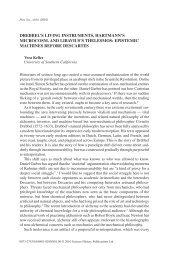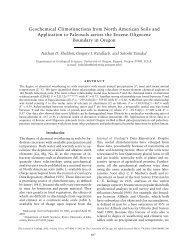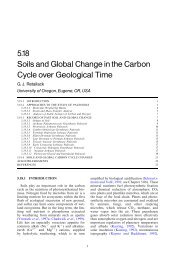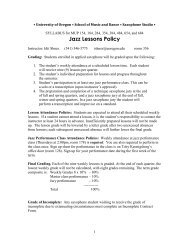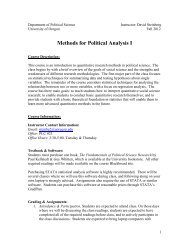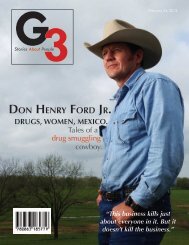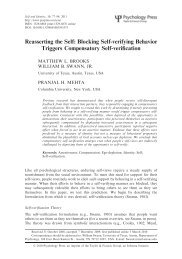Retallack 2007 Proserpina principle - University of Oregon
Retallack 2007 Proserpina principle - University of Oregon
Retallack 2007 Proserpina principle - University of Oregon
You also want an ePaper? Increase the reach of your titles
YUMPU automatically turns print PDFs into web optimized ePapers that Google loves.
modern forest soils under oak–hickory forest.The 42 and 23 ka interstadials are defined bypaleosols such as the Farmdale paleosol, whichis comparable with modern boreal forest paleosolsunder spruce forest (Follmer et al., 1979).Ice, till, loess, and periglacial soils (Gelisols) alternatedwith forest soils (Alfisols or Inceptisols)through these paleoclimatic fluctuations.Oscillations between different ecosystemscan be inferred from many paleosol sequences,even beyond the ice margin (Figure 15). In thePalouse loess <strong>of</strong> Washington, for example,grassland soils (Mollisols) with crumb pedsand earthworm castings during interglacialsand interstadials alternate with sagebrush soils(Aridisols) with cicada burrows and shallowcarbonate horizons during glacials and interstadialminima (Busacca, 1989; O’Geen andBusacca, 2001). Vegetation <strong>of</strong> the paleosols canbe inferred from carbon isotopic values typicalfor CAM saltbush in the sagebrush paleosols,and for C 3 grasses in the grassland paleosols, aswell as from the characteristic phytoliths <strong>of</strong>these plants (Blinnikov et al., 2002). Comparablealternations <strong>of</strong> ecosystems with paleoclimaticfluctuation are seen in many Quaternarysequences <strong>of</strong> paleosols (Paepe and van Overloop,1990; Feng et al., 1994; Wang et al.,1998). Differences in primary production andcarbon sequestration <strong>of</strong> these alternatingecosystem types on a global basis may haveplayed a role in the relative abundance <strong>of</strong>greenhouse gases during glacial–interglacialpaleoclimatic cycles.Ice core records show as little as 180 ppmvCO 2 during glacial periods and 280 ppmvduring interglacials, in a strongly asymmetricpattern <strong>of</strong> gradual drawdowns followed bysteep rises known as terminations (Figure 2b).Even higher CO 2 levels during interglacials areprevented by high plant productivity <strong>of</strong> forestsin humid, previously glaciated terrains and <strong>of</strong>grasslands in arid rangelands. This slow weatheringand biomass building, together with nutrientleakage to the ocean and carbon burialthere, could draw down greenhouse gases andbring on cooling. As ice expands and grasslandsare converted into deserts, the carbonsequestration capacity <strong>of</strong> soils and ecosystemsis diminished. Large herds <strong>of</strong> mammals orpopulations <strong>of</strong> humans could disturb theseimpoverished soils into dustbowl conditionsand the massive carbon oxidation events <strong>of</strong> aglacial termination. Such long-term biologicaltrends, metered by steadily declining and thenabruptly renewed soil nutrients, could amplifyother drivers <strong>of</strong> climate, which include largeice caps, ocean currents, mountain building,and orbital configuration (Muller and Mac-Donald, 2000).Soils and Global Carbon Cycle Changes 215.18.4 SOILS AND GLOBAL CARBONCYCLE CHANGESOver geological time there have been dramaticchanges in soil, life, and air that are wellrepresented in the fossil record <strong>of</strong> soils. Paleosolsare an underexploited record <strong>of</strong> pastenvironments in land. This review has emphasizedmainly the evidence from paleosols forchanges in carbon cycling and greenhouse gases(CO 2 ,CH 4 , and H 2 O) in the atmosphere overgeological timescales. It is unremarkable thatpaleosols would change, particularly at highlatitudes, as global climates warmed or cooledwith changing atmospheric loads <strong>of</strong> greenhousegases. It is notable that sequences <strong>of</strong> paleosolscan, under certain circumstances, be high-resolutionrecords <strong>of</strong> such paleoclimatic change(Figure 15). Parallels between biological activitywithin soils and greenhouse gas compositionhave been emphasized in this review as fertileground for future research (Figure 16). Olsen(1993) has suggested that soil producers such asplants cool the planet, but soil consumers suchas animals warm it. This idea, which the authorhas dubbed the <strong>Proserpina</strong> <strong>principle</strong> after theancient Roman goddess <strong>of</strong> spring (<strong>Retallack</strong>,2000b), is undeniable for the annual spring falland autumn rise <strong>of</strong> atmospheric CO 2 withnorthern hemisphere leaf sprouting and shedding(Figure 2a). This explanation is especiallydemonstrated by the muted and out-<strong>of</strong>-phaseannual fluctuation <strong>of</strong> CO 2 in the southern hemisphere(Mooney et al., 1987), where there isless fertile land, more evergreen plants, anddifferent seasons. The question addressed hereis whether the <strong>Proserpina</strong> <strong>principle</strong> operates ongeologically significant timescales, and so far,such a simple idea does not conflict with thehistory <strong>of</strong> life and paleoclimate outlined here.On evolutionary timescales, it is the biochemicalevolution <strong>of</strong> lignin, pyrethrin, caffeine, andother substances that deter herbivory, digestion,and decay, which affect rates <strong>of</strong> carbon burial insediments as the principal long-term control onatmospheric CO 2 levels. The role <strong>of</strong> trees andtheir soils in Late Paleozoic carbon sequestration,cooling, and glaciation is widely accepted(Berner, 1997; Algeo and Scheckler, 1998; seeChapter 5.06). The role <strong>of</strong> humans in globalwarming is also becoming well known (Vitouseket al., 1997b). According to the <strong>Proserpina</strong><strong>principle</strong>, humans may not have been theonly organisms to have had significant effectson climate. There remain many other instances<strong>of</strong> global change less clearly related to changesin life and soils, in part because the numerouspaleosols <strong>of</strong> appropriate age have not yet beenstudied in detail. Asteroid impacts, volcaniceruptions, and methane outburst events also



